Why are tolerances and fits the most important in the machinery industry? 100 questions and answers highlights!
Read this article carefully - about tolerance and cooperation, to understand and understand, the following questions can find the answer!
What is the limit size? What is the basic deviation? What is the tolerance? What are the different tolerance levels applied to?
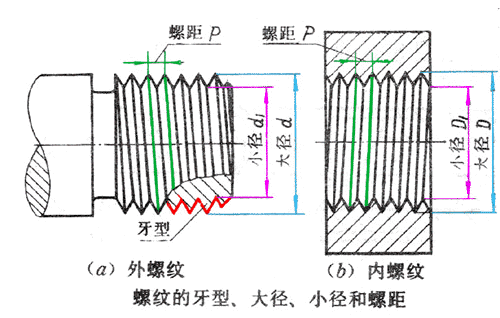
1. What is called tolerance?
A: Allowing variations in part size and geometry parameters is called tolerance.2. What is called size?
A: A number that represents the length value in a specific unit.3. What is called the basic size?
A: Make the design a given size.4. What is the actual size?
A: It is the size obtained by measurement.5. What is the limit size?
A: Refers to the two limits that allow for dimensional changes.6. What is called Maximum Entity Status (MMC) and Maximum Entity Size?
A: The maximum solid state refers to the state in which the hole or shaft is within the dimensional tolerance range and has the largest amount of material. The size in this state, called the maximum physical size, is a general term for the minimum limit size of the hole and the maximum limit size of the shaft.7. What is called the minimum entity state (LMC for short) and the minimum physical size?
A: The minimum solid state refers to the state in which the hole or shaft is within the dimensional tolerance and has the least material. The size in this state, called the minimum physical size, is a general term for the maximum limit size of the hole and the minimum limit size of the shaft.8. What is the size of the action?
A: The maximum ideal shaft size that is inscribed with the actual hole over the entire length of the mating surface is called the effective size of the hole. The size of the smallest ideal hole circumscribing the actual axis is called the effective size of the shaft.9. What is called dimensional deviation?
A: It refers to the algebraic difference obtained from a certain size minus its basic size.10. What is called dimensional tolerance?
A: It refers to the amount of change in the allowable size.11. What is called the zero line?
A: In the tolerance and mating diagram (referred to as the tolerance band diagram), determine a reference line of deviation, that is, zero deviation line.12. What is the tolerance band?
A: In the tolerance zone diagram, an area defined by two straight lines representing the upper and lower deviations.13. What is the basic deviation?
A: It is used to determine the upper or lower deviation of the tolerance zone relative to the neutral position, generally referring to the deviation from the zero line. When the tolerance band is above the zero line, the basic deviation is the lower deviation; when it is below the zero line, the basic deviation is the upper deviation. see picture 1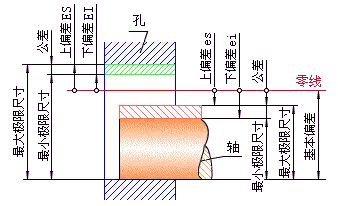
14. What is called standard tolerance?
A: Any tolerance specified by the national standard to determine the tolerance band size.15. What is called cooperation?
A: Refers to the relationship between the hole and the shaft tolerance band of the same basic size.16. What is the base hole system ?
Answer: It is a system in which the basic deviation is a certain tolerance zone of the hole, and the tolerance band of the axis with different basic deviations forms a kind.17. What is the basic axis system?
A: It is a system in which the basic deviation is a certain tolerance zone of the shaft, and the tolerance zone of the hole with different basic deviations forms various cooperations.18. What is the tolerance?
A: It is the allowable variation of the gap. It is equal to the absolute value of the algebraic difference between the maximum gap and the minimum gap. It is also equal to the sum of the hole tolerance band and the shaft tolerance band.19. What is called clearance fit?
A: The tolerance band of the hole is completely above the tolerance band of the shaft, ie the fit with clearance (including the fit with a minimum clearance equal to zero).20. What is the interference fit?
A: The tolerance band of the hole is completely below the tolerance band of the shaft, ie it has an interference fit (including a fit with a minimum interference equal to zero).twenty one. What is called transition fit?
Answer: In the cooperation between the hole and the shaft, the tolerance bands of the hole and the shaft overlap each other. Any one of the holes and the shaft may match, and may have a gap or an interference fit.twenty two. What is the priority fit characteristic when the base hole is made of H11/c11 or the base shaft is made of C11/h11?
A: The gap is very large, it is used for very loose, slow-moving dynamic fits; exposed components requiring large tolerances and large gaps; loose fittings that require easy assembly. Equivalent to the old national standard D6/dd6.twenty three. When the base hole is made of H9/d9 or the base shaft is made of D9/h9, what is the priority fit characteristic?
A: A freely-rotating fit with a large clearance for non-critical requirements, or when there is a large temperature change, high rotational speed or large journal pressure. Equivalent to the old national standard D4/de4.twenty four. What is the priority fit characteristic when the base hole is made of H8/f7 or the base shaft is made of F8/h7?
A: The small rotation fit is used for precise rotation of medium and medium journal pressures; it is also used for easy intermediate positioning. Equivalent to the old national standard D/dc.25. What is the priority fit characteristic when the base hole is made of H7/g6 or the base shaft is made of G7/h6?
A: Slip fit with small clearance for undesired free rotation, but free to move and slide and requires precise positioning, it can also be used for a clear positioning fit. Equivalent to the old national standard D/db.26. The base hole is made of H7/h6; H8/h7; H9/h9; H11/h11 or base shaft is made up of H7/h6; H8/h7; H9/h9; H11/h11, the preferred compounding property is what?
Answer: All the gaps are positioned and matched, the parts can be freely assembled and disassembled, and the work is generally relatively stationary. The gap under the maximum solid condition is zero, and the gap under the minimum solid condition is determined by the tolerance level. H7/h6 is equivalent to the old national standard D/d; H8/h7 is equivalent to the old national standard D3/d3; H9/h9 is equivalent to the old national standard D4/d4; H11/h11 is equivalent to the old national standard D6/d6.27. What is the priority fit characteristic when the base hole is made of H7/h6 or the base shaft is made of K7/h6?
A: Transitional coordination for precise positioning. Equivalent to the old national standard D/gc.28. What is the priority fit characteristic when the base hole is made of H7/n6 or the base shaft is made of N7/h6?
A: The transition fit allows for more precise positioning with greater interference. Equivalent to the old national standard D/ga.29. What is the priority fit characteristic when the base hole is made of H7/p6 or the base shaft is made of P7/h6?
Answer: The interference positioning coordination, that is, the small interference fit, can be used to achieve the rigidity and neutrality requirements of the component with the best positioning accuracy when the positioning accuracy is particularly important, and the internal hole has no special requirements with the pressure, and does not depend on The tightness of the fit conveys the friction load. Equivalent to the old national standard D/ga~D/jf. Where H7 is less than or equal to 3 mm is a transition fit.30. What is the priority fit characteristic when the base hole is made of H7/s6 or the base shaft is made of S7/h6?
A: Medium press fit, suitable for general steel parts; or for cold shrink fit of thin-walled parts, for the tightest fit of cast iron parts, equivalent to the old national standard D/je.31. When the base hole is made of H7/u6 or the base shaft is made of U7/h6, what is the priority matching characteristic?
A: Press fit, suitable for parts that can be pressed with large force or cold shrink fit that should not withstand large press-in force.32. What is the matching characteristic when the basic deviation of the axis is a; b?
Answer: It is a clearance fit, which can get a particularly large gap and is rarely used.33. What is the fit characteristic when the basic deviation of the axis is c?
Answer: It is a clearance fit, which can get a large gap. It is generally suitable for slow and slack dynamic fit. For poor working conditions (such as agricultural machinery), deformation, or for ease of assembly, the surface must be guaranteed to have a large gap. It is recommended to cooperate with H11/c11, and its higher level of cooperation, such as H8/c7, is suitable for the tight dynamic coordination of one shaft working at high temperature, such as exhaust valve and conduit of internal combustion engine.34. What is the mating characteristic when the basic deviation of the axis is d?
Answer: It is a clearance fit. It is generally used for IT7~IT11. It is used for loose rotation, such as sealing cover, pulley, idle pulley and so on. It is suitable for large-diameter sliding bearing mating, such as turbines, ball mills, roll forming and heavy bending machines and some sliding bearings in other heavy machinery.35. What is the mating characteristic when the basic deviation of the axis is e?
A: It is a clearance fit, mostly used for IT7~IT9. It is usually suitable for support coordination with obvious clearance and easy rotation, such as large span and multi-support. The high-grade e-axis is suitable for large, high speed and heavy load. Supporting fits, such as worm gear generators, large motors, internal combustion engines, camshafts and rocker arms.36. What is the mating characteristic when the basic deviation of the axis is f?
Answer: It is a clearance fit, which is mostly used for the general rotation coordination of IT6~IT8. When the temperature is not greatly affected, it is widely used for the lubrication of ordinary lubricating oil (fat), such as the cooperation of the rotating shaft of the gear box, small motor, pump, etc. with the sliding bearing.37. What is the fit characteristic when the basic deviation of the axis is g?
Answer: It is a clearance fit, the clearance is small, the manufacturing cost is high, and it is not recommended for the rotary fit except for the delicate device with very light load. It is mostly used in IT5~IT7 grades. It is most suitable for precision sliding fit without rotation. It is also used for positioning and matching such as bolts, such as precision connecting rod bearings, pistons, slide valves and connecting rod pins.38. What is the mating characteristic when the basic deviation of the axis is h?
A: It is a gap fit, mostly used for IT4~IT11. Widely used for parts without relative rotation, as a general positioning fit, if there is no temperature deformation effect, it is also used for precision sliding fit.39. What is the fit characteristic when the basic deviation of the axis is js?
A: It is a transitional fit, which is a completely symmetric deviation (+IT/2). The average is a slightly clearance fit, mostly for IT4-7, requiring clearances smaller than the h-axis and allowing for slightly interference positioning (such as couplings) that can be assembled with a hand or a wooden hammer.40. What is the mating characteristic when the basic deviation of the axis is k?
A: It is a transitional fit, with an average of no gaps, suitable for IT4-IT7. It is recommended for positioning and fitting with slight interference. The inverted table is used to eliminate the positioning and matching of vibration. Usually assembled with a wooden hammer.41. What is the mating characteristic when the basic deviation of the shaft is m?
A: It is a transitional coordination, with an average of small transitions. Applicable to IT4I-T7, assembled with a hammer or press, usually recommended for tight component fit. H6/n5 is an interference fit when mated.42. What is the fit characteristic when the basic deviation of the axis is n?
A: It is a transitional fit. The average interference is slightly larger than the m-axis. There is very little gap. It is suitable for IT4-IT7. It is assembled with a hammer or a press. It is usually recommended for tight component fit. H6/n5 is an interference fit when mated.43. What is the mating characteristic when the basic deviation of the axis is p?
Answer: It is an interference fit. When it is matched with H6 or H7, it is an interference fit. When it is matched with H8 hole, it is a transition fit. For non-ferrous parts, a lighter press-fit fits and is easy to remove when needed. For steel, cast iron or copper, steel assembly is a standard press fit.44. What is the fit characteristic when the basic deviation of the axis is r?
A: It is an interference fit. It is a medium fit for iron parts. For non-ferrous parts, it can be disassembled when needed. Cooperate with the H8 hole, the interference fit is more than 100mm in diameter, and the diameter is small for the transition fit.45. What is the mating characteristic when the basic deviation of the axis is s?
A: It is an interference fit for permanent and semi-permanent assembly of steel and iron parts. Can produce considerable bonding force. When an elastic material such as a light alloy is used, the compounding property is equivalent to the P axis of the iron component. For example, the collar is press-fitted on the shaft, the valve seat, and the like. When the size is large, in order to avoid damage to the mating surface, thermal expansion or shrinkage assembly is required.46. The basic deviation of the axis is t; u; v; x; y; z, what is the mating characteristic?
A: It is an interference fit, and the amount of interference increases in turn, which is generally not recommended.47. When is the base shaft system selected?
A: Cold-drawn steel that is manufactured with a tolerance class (normally 8 to 11) and is no longer machined by the tolerance band of the reference axis is used directly. At this point, different hole tolerance band positions can be selected to create a variety of different fit requirements. In agricultural machinery and textile machinery, this situation is more.
It is much more difficult to machine a precision shaft with a size of less than 1 mm than to machine a hole of the same level. Therefore, in the instrument manufacturing, watch production, radio and electronics industries, it is common to use a thin steel wire that has been tempered to form a shaft. The shaft system is better than the base hole system.From the structural point of view, a single shaft is matched with several holes in different parts, and each has different fitting requirements. In this case, the base shaft should be considered.
48. How does it work with standard parts?
A: If it is matched with the standard parts, the standard part should be used as the reference part to determine the matching system.
For example, in the rolling bearing support structure, the cooperation of the outer ring of the rolling bearing and the hole of the box should be made by the base shaft, and the cooperation between the inner ring of the bearing and the journal should be made by the base hole, the hole of the box is made according to J7, and the journal is made by k6.49. What is the range of tolerance levels for the grinding method?
A: IT1~IT5 should be taken.50. What is the range of tolerance levels that should be taken?
A: IT4~IT7 should be taken.51. What is the scope of tolerance for diamond car processing?
A: IT5~IT7 should be taken.52. What is the range of tolerance levels for diamond boring?
A: IT5~IT7 should be taken.53. What is the range of tolerance levels for round grinding?
A: IT5~IT8 should be taken.54. What is the range of tolerance levels for the flat grinding method?
A: IT5~IT8 should be taken.55. What is the range of tolerance levels for broaching?
A: IT5~IT8 should be taken.56. What is the scope of the tolerance class?
A: IT7~IT9 should be taken.57. What is the range of tolerance levels for reaming?
A: IT6~IT10 should be taken.58. What is the range of tolerance levels for milling?
A: IT8~IT11 should be taken.59. What is the range of tolerance levels for planing and inserting?
A: IT10~IT11 should be taken.60. What is the range of tolerance levels for rolling and extrusion processing?
A: IT10~IT11 should be taken.61. What is the range of tolerance levels for roughing?
A: IT10~IT12 should be taken.62. What is the range of tolerance levels for rough machining?
A: IT10~IT12 should be taken.63. What is the range of tolerance levels for drilling methods?
A: IT10~IT13 should be taken.64. What is the range of tolerance levels for stamping?
A: IT10~IT14 should be taken.65. What is the range of tolerance class for sand casting?
A: IT14~IT15 should be taken.66. What is the range of tolerance class for metal casting?
A: IT14~IT15 should be taken.67. What is the range of tolerance levels for forging processing?
A: IT15~IT16 should be taken.68. What is the range of tolerance levels for gas cutting?
A: IT15~IT18 should be taken.69. How many ways to determine the basic deviation?
A: There are three ways to determine the basic deviation: test method, calculation method and analogy method.70. What is the test method?
A: The test method is to apply the test method to determine the type of cooperation that satisfies the product's working performance. It is mainly used in some key institutions such as aerospace, aviation, defense, nuclear industry and railway transportation industry. It has great influence on product performance and lacks experience. An important, critical fit. This method is more reliable. The disadvantage is that it needs to be tested, with high cost and long cycle. Less application.71. What is the calculation method?
A: The calculation method is based on the use requirements to determine the type of cooperation through theoretical calculations. The advantage is that the theoretical basis is sufficient, and the cost is lower than the test method. However, since the theoretical calculations cannot consider the various practical factors of the working environment of the machine and equipment to be very comprehensive, the design scheme is not as accurate as determined by the test method. For example, when the calculation method is used to determine the type of fit of the sliding bearing clearance fit, the minimum allowable clearance can be calculated according to the liquid lubrication theory, and the appropriate type of fit can be selected from the standard; the calculation method is used to determine the load that is completely transmitted by the interference. When the type of the fit is matched, according to the magnitude of the load to be transmitted, according to the theory of elastic and plastic deformation, the minimum interference required can be calculated, and the appropriate type of interference fit can be selected accordingly, and the strength of the material of the part can be checked to bear the type of the fit. The maximum interference produced. Because of the many factors affecting the fit gap and interference, the theoretical calculation can only be approximate.72. What is the analogy?
A: The analogy method is based on the cooperation with the production practice in the same type of machine or organization as the design task, and combined with the actual requirements of the design requirements and application conditions of the designed product. This method is the most widely used, but requires designers to have sufficient reference materials and considerable experience. The factors that should be considered when using the analogy method to determine the fit are as follows:The size of the force. When the force is large, the trend tends to be tightly selected, that is, the interference of the interference fit should be appropriately increased, the gap of the clearance fit should be reduced, and the transition fit with a high probability of obtaining interference should be selected.
Disassembly and assembly and structural features. For the fittings that are frequently disassembled, the fit should be looser than the same fit for the tasks that are not frequently disassembled. The assembly of difficult assembly should also be a little looser.
Combine length and shape error. The longer the mating length, due to the presence of the shape error, the tighter the actual fit is compared to the shorter joint length. Therefore, it is advisable to use a loose fit.
Material, temperature. When the materials of the phase fittings are different (the linear expansion coefficients differ greatly) and the operating temperature differs greatly from the standard temperature +20 °C, the influence of thermal deformation should be considered. The effect of assembly deformation.
73. When the tolerance level is 5, what is the application?
Answer: It is mainly used in the occasions where the tolerances and shape tolerances are very small, and the coordination property is stable. It is generally applied in important parts such as machine tools, engines and meters. For example, the box hole matched with the D-class rolling bearing; the machine tool spindle matched with the E-class rolling bearing, the machine tailstock and sleeve, the journal in precision machinery and high-speed machinery, and the precision screw diameter.74. When the tolerance level is 6, what is the application?
Answer: The matching property can achieve high uniformity, such as the hole and journal which cooperate with the E-class rolling bearing; the shaft diameter connected with the gear, the worm wheel, the coupling, the pulley, the cam, etc., the shaft diameter of the machine tool; Rocker drill column; outer diameter of the guide in the machine tool fixture; reference hole for the 6-stage precision gear, 7th and 8th gear reference axis.75. When the tolerance level is 7, what is the application?
Answer: The accuracy of 7 is slightly lower than that of the 6th grade. The application conditions are basically similar to those of the 6th grade. It is widely used in general mechanical manufacturing. Such as coupling, pulley, cam and other apertures; machine chuck cavity hole, fixed drill sleeve in the fixture, can be replaced with drill sleeve; 7 and 8 gear reference hole, 9, 10 gear reference axis.76. When the tolerance level is 8, what is the application?
A: It is medium precision in machine building. For example, the bearing bushing is dimensioned in the width direction, 9 to 12 gear reference holes; 11 to 12 gear reference axes.77. When the tolerance level is 9-10, what is the application?
Answer: It is mainly used for the outer diameter and hole of the bushing in mechanical manufacturing; the control member and the shaft; the idle shaft pulley and the shaft; single button and spline.78. When the tolerance level is 11 to 12, what is the application?
Answer: The precision of the matching is very low, and there may be a large gap after assembly. It is suitable for occasions where there is basically no matching requirement. Such as flanges and stops on machine tools; sliding and slipping gears; dimensions between processes; machining fittings; connection of wrench holes and wrench seats in machine tool manufacturing79. How to choose the clearance fit in the actual design?
A: See Figure 2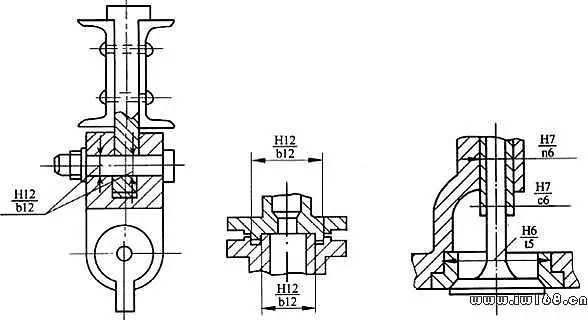
Hinges for crane hooks, flanged flanges, exhaust valves and conduits for internal combustion engines
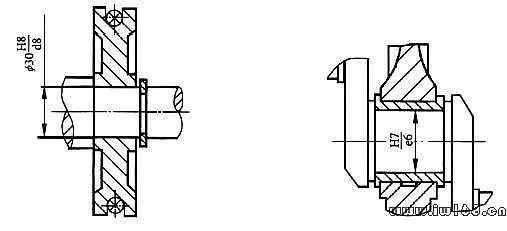
Coordination of the pulley and the shaft to match the internal combustion engine spindle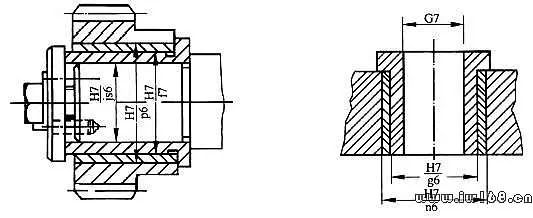
Coupling of gear bushing and shaft with drill bushing and bushingFig. 2
80. How to choose the transition fit in the actual design?
A: See Figure 3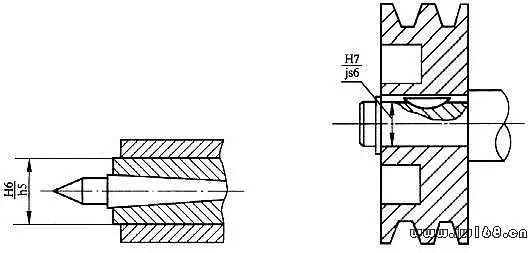
Coupling of the top sleeve of the lathe tailstock with the shaft

Coordination of the worm gear bronze rim and spoke of rigid coupling
81. How to choose the interference fit in the actual design?
A: See Figure 4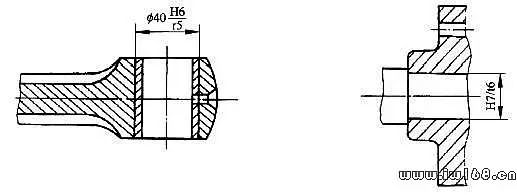
Figure 4
82. How to mark the linear dimension tolerance on the part drawing?
A: See Figure 5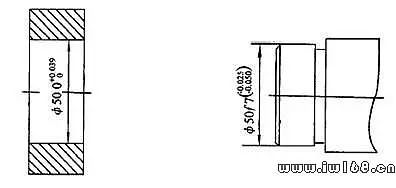
Figure 5
83. How to mark the linear dimension tolerance on the assembly drawing?
A: See Figure 6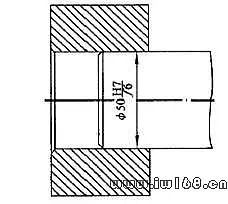
Figure 6
84. How to mark the linear dimension tolerance of standard parts?
A: See Figure 7
Figure 7
85. What are the requirements for linear dimensional tolerance marking?
A: The tolerance code is the same as the basic size number.
When the linear dimension tolerance is marked with the limit deviation, the upper and lower deviation numbers are smaller than the basic size number, and the upper and lower deviation decimal points must be aligned and marked with a sign.One of the deviations is zero, which can be marked with "0" and aligned with another deviation single digit.
The lower deviation bottom line is on the same bottom line as the basic size.
When the upper and lower deviation values ​​are equal, the deviation is only written once, and a “+/-†sign is placed between the deviation and the basic size, and the two font numbers are the same.
86. What is a conical fit?
Answer: The relationship between the inner and outer cone diameters of the same basic cone is due to the combination of different combinations. The mating feature of the conical fit is to create a gap or interference by the axial position defined by the inner and outer cones that are joined to each other. The gap or interference acts in a direction perpendicular to the surface of the cone, but is given and measured perpendicular to the direction of the axis of the cone; a cone with a taper of less than or equal to 1:3, perpendicular to the surface of the cone and a value perpendicular to the axis of the cone The difference between the two is negligible. According to the different methods of determining the axial position of the inner and outer cones, the conical fitting is divided into two types: structural conical fitting and displacement conical fitting.
87. What is called a structural cone fit?
A: The fit obtained by determining the relative axial position of the inner and outer cones by the structure itself or the structural dimensions.88. What is called a displacement cone fit?
A: The magnitude of the axial displacement or the axial force that produces the axial displacement is determined to determine the fit of the inner and outer cones relative to the axial position.89. What three items does the standard tolerance series consist of?
A: Segmented by tolerance class, tolerance unit and basic size.90. What is called general tolerance?
Answer: It refers to the tolerance that can be achieved by the general processing capability of machine tools under the common process conditions of the workshop.91. What is the general tolerance for linear dimensions in GB/T1804-1992?
A: Four tolerance levels are specified for f, m, c, and v. The letter f indicates the precision level, m indicates the medium level, c indicates the coarse level, and v indicates the coarsest level. The tolerance levels f, m, c, and v are equivalent to IT12, IT14, lt16, and IT17, respectively.92. What is the limit deviation value table for the general tolerance of linear dimensions?
A: See Table 1Table 1

93. What is the limit deviation value table for rounding radius and chamfer height?
A: See Table 2Table II

94. What should you pay attention to when matching the gap?
Answer: The reference hole H (or the reference axis h) forms a clearance fit with the axes a to h (or holes A to H) of the corresponding tolerance class, a total of 11 types, of which
The gap composed of H/a (or A/h) is the largest, and the fit gap of H/h is the smallest.H/a (A/h), H/b (B/h), and H/c (C/h) are combined. The gaps of these three types are large and are not commonly used. Generally used in machinery with poor working conditions, requiring flexible operation, or for large deformation of the force, the shaft should work at high temperature to ensure a large gap.
H/d (D/h) and H/e (E/h) are combined, and the two kinds of matching gaps are large, and are used for the support that is not required to be easy to rotate. Among them, H/d(D/h) is suitable for loose coupling, such as sealing cover, pulley and idle pulley. It is also suitable for the matching of large-diameter sliding bearings, such as ball bearings, rolling mills and other heavy machinery sliding bearings, suitable for IT7 ~ IT11. For example, the cooperation of the pulley and the shaft.
H/f (F/h) fit, this fit has a moderate gap, and is mostly used for the general drive coordination of IT7~IT9, such as the coordination of the shaft and sliding support of gearbox, small motor, pump, etc.
H/g (G/h) fit, this kind of matching gap is very small, in addition to the very light-loaded precision mechanism, generally do not need to make a rotary fit, mostly used for IT5 ~ IT7 grade, suitable for the precision fit of reciprocating swing and sliding. For example, the combination of the drill sleeve and the bushing.
H/h fit, the minimum clearance of this fit is zero. It is used for IT4~IT11. It is suitable for positioning and matching without centering and guiding requirements without relative rotation. If there is no temperature and deformation, it is also used for sliding fit. With H6/h5, H7/h6, H8/h7, H9/h9 and H11/h11.
95. What should you pay attention to when transitioning?
Answer: The reference hole H forms a transition fit with the basic deviation code j~n of the corresponding tolerance class axis (n forms an interference fit with the high precision hole).H/j, H/js cooperate, these two transitions have more chances of obtaining clearance, and are mostly used for IT4~IT7. It is suitable for positioning coordination where the clearance is smaller than h and allows slight interference, such as couplings, Ring gear and steel hub and the cooperation of rolling bearing and box.
H/k fit, the average clearance obtained by this kind of fit is close to zero, the centering is better, the contact stress of the parts after assembly is small, and it can be disassembled, which is suitable for IT4~IT7 grade, such as the cooperation of rigid coupling.
H/m and H/n are combined. These two kinds of cooperation have many chances of gaining profit. The centering is good and the assembly is tight. It is suitable for IT4~IT7.
96. What should you pay attention to when making interference fit?
Answer: The reference hole H forms an interference fit with the basic deviation code p~zc of the corresponding tolerance class axis (p, r forms a transition fit with the lower precision H hole).H/p, H/r fit, these two kinds of fits are interference fits at high tolerance levels, can be assembled by hammer or press, and should only be disassembled during overhaul. It is mainly used for positioning and matching with high precision of centering, sufficient rigidity of parts and impact load, and is mostly used for IT6~IT8.
H/s, H/t, these two kinds of cooperation are moderate interference fit, and more use IT6, IT7 level. Used for permanent or semi-permanent bonding of steel parts. Without the aids, relying on the combined force generated by the interference, the medium load can be directly transmitted. It is generally assembled by pressure method, and it can also be assembled by cold shaft or hot sleeve method, such as the assembly of cast iron wheel and shaft, and the fit of the column, pin, shaft, sleeve and the like into the hole.
H/u, H/v, H/x, H/y, H/z fit, these are a large interference fit, the interference increases in turn, and the ratio of interference to diameter is above 0.001. They are suitable for transmitting large torques or with large impact loads, relying entirely on the bond generated by the interference to ensure a firm connection, usually assembled by hot or cold shaft method. The cast steel wheels of the train and the high manganese steel wheels should be matched with H7 / u6 or even H6 / u5. Due to the large profit, the parts are required to be of good material quality and high strength. Otherwise, the parts will be cracked. Therefore, it should be used with caution and generally must be tested before it can be put into production. Before assembly, it is often necessary to select, so that the interference of a batch of accessories tends to be consistent and moderate.
97. Why is the base hole system preferred?
A: Because the hole is difficult to machine, changing the size of the hole requires changing the number of tools and gauges. Changing the size of the shaft does not change the number of tools and gauges.98. How is the tolerance level applied?
A: See Table 3Table 3
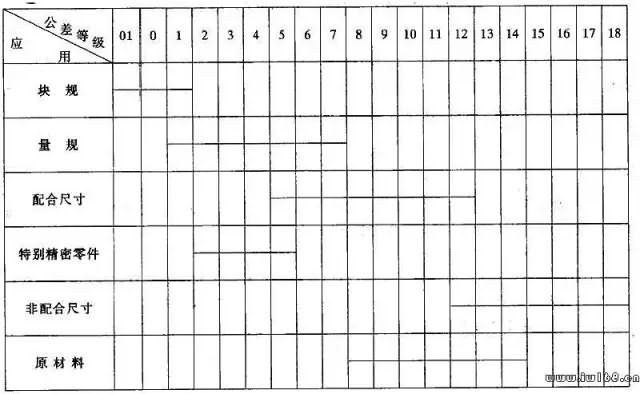
99. How do you use the requirements to determine the type of fit?
A: When the hole and the shaft move relative to each other or rotate, the clearance fit must be selected. The relative movement is selected to select a fit with a small gap, and the relative rotation selects a fit with a larger gap.When there is no key, pin, screw and other couplings between the hole and the shaft, the transmission can only be achieved by the cooperation between the hole and the shaft.
The characteristics of the transition fit are that there may be gaps and interference, but the amount of gap or interference is relatively small. Therefore, when there is no relative motion between the parts, the concentricity is high, and the power is not transmitted by the fit, the transition fit is often selected.
100. What are the principles for the selection of dimensional tolerances and fits?
A: The principle of selection is to obtain the best technical and economic benefits while meeting the requirements of use.
Door Handle On Plate,Large Plate Door Handle,Bathroom Plate Door Handle,Aluminum Plate Door Handle
Wenzhou Shenghong Metal Products Co.,Ltd , https://www.shenghonglock.com